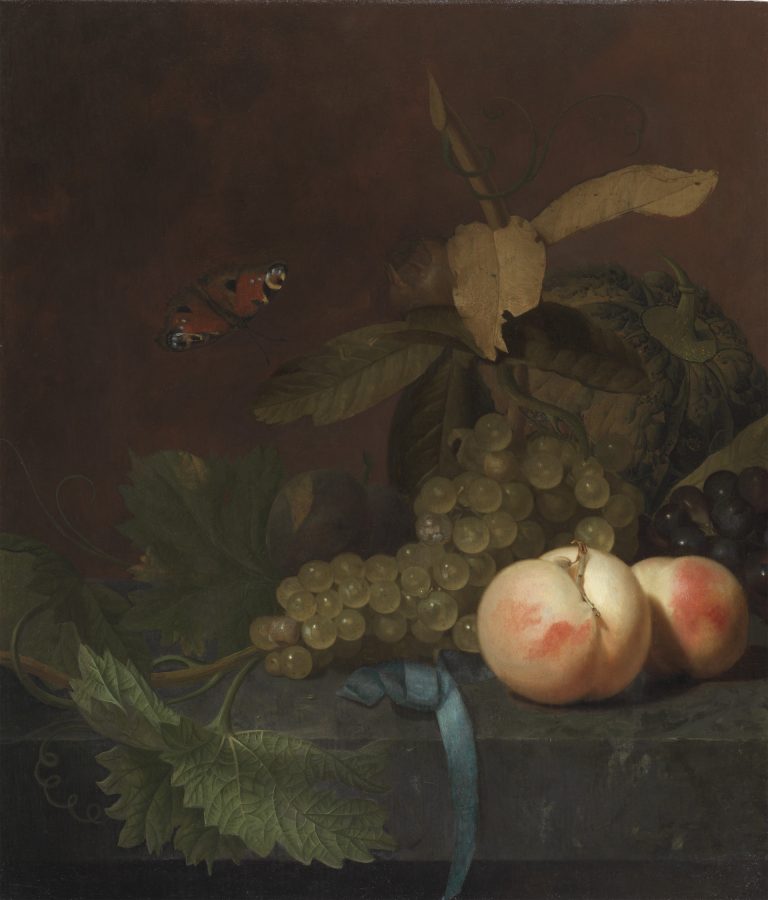Prior to the appearance of Still Life with Peaches, Grapes, and Melon and a Butterfly on a Stone Plate in a London sale in 2001, only two still lifes by Godefridus Schalcken were known.1 Much excitement surrounded this discovery because the attribution was deemed correct, both because the painting was signed and because Schalcken featured similar peaches and grapes in other paintings. Indeed, Schalcken’s best-known still life is A Bunch of Grapes in Stockholm, a canvas that Peter Hecht has convincingly related to late seventeenth-century theoretical discussions about the best way for artists to study chiaroscuro.2
The still life ensemble includes two bunches of grapes—one red and one white—that rest on a green stone plinth, at the edge of which are two peaches and a blue ribbon. Behind the grapes is a large yellow-green melon, on top of which lie a medlar and a branch with dried, yellowish leaves that contrast with the dark, reddish-brown background.3 Hovering at the left is a Red Admiral butterfly (Vanessa atalanta), which is still commonly found in the Netherlands. A dark strip approximately two centimeters wide extends across the lower edge of the panel.
Although the signature at first seems to support an attribution of this painting to Schalcken, its character actually differs from the artist’s normal manner of signing. To begin with, the artist’s name is not rendered with his usual, powerful brushwork on the stone plinth, which would have been the logical place for him to sign this work. Rather, the signature is rather hesitantly drawn at the extreme lower right with a fine brush and black paint on the dark background, barely discernible to the naked eye. Uncharacteristically, the G is placed somewhat lower than normal and the E is higher than the other letters, which look straggly compared to the firmly defined strokes of his usual hand.4 It now appears that the signature is apocryphal and was added at a later date. Stylistic comparisons also call into question this painting’s attribution to Schalcken. Not only is the palette different, but the painting lacks the painter’s flowing brushwork.5
An interesting comparison can be made between the two peaches in this painting and those in Schalcken’s Portrait of a Lady, 1680, and his Venus with Cupid, Bacchus and Ceres in Prague, which also dates around 1680.6 As Meijer has rightly observed, Schalcken’s peaches in the latter two paintings are stylistically similar to those executed by his contemporary from Dordrecht, Abraham van Calraet (1642–1722). In 1678 Schalcken’s teacher, Samuel van Hoogstraten (1627–78), published his Inleyding tot de hooge schoole der schilderkonst (“Introduction to the Academy of Painting”), in which he praised Van Calraet—though not by name—for distinguishing himself “by portraying a large dish piled high with beautiful peaches, extremely juicy and perfectly rendered.” 7 As a young artist, Schalcken undoubtedly studied Van Hoogstraten’s book and shared his teacher’s admiration for Van Calraet’s manner of depicting peaches, as is evident in the way he modeled peaches in the two paintings executed around 1680.8
Even if Schalcken were inspired by Van Calraet, there is no evidence that he made fruit and flower still lifes at that time: these only appear in his English period (1692–96). A Bouquet of Flowers in Oxford can be dated to the 1690s, and a similarly late date holds true for A Bunch of Grapes in Stockholm.9 By that period of his career, Schalcken’s style had evolved, and neither of these still life paintings is reminiscent of those by Van Calraet.10 Strikingly, however, Still Life with Peaches, Grapes, and Melon and a Butterfly on a Stone Plate is closely related in composition, pictorial elements and workmanship to one of Van Calraet’s earliest known still lifes, in which he depicted a bunch of white grapes and five peaches on a plinth with two Red Admiral butterflies.11 Further research is needed to determine whether the present painting can actually be attributed to Van Calraet, but without doubt this painting is closer in style to Van Calraet’s still lifes than to those made by Schalcken.
A date of execution around 1670 is supported by dendrochronological examination. The panel’s last complete growth ring dates from 1646, which means that the West European oak that supplied the wood for this panel was felled after 1654. The still life is therefore likely to have been completed between 1660 and 1680.12
